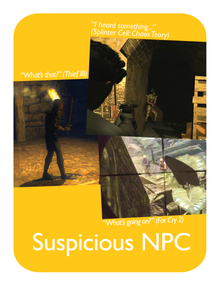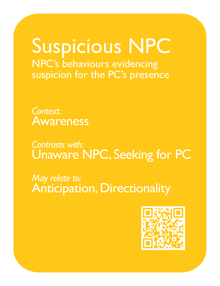Difference between revisions of "Suspicious NPC"
ValterAlves (Talk | contribs) m |
ValterAlves (Talk | contribs) m |
||
| Line 1: | Line 1: | ||
{{Card | {{Card | ||
| notesontop= This is a candidate pattern, which may enter version 2.0 of the [[Deck]]. | | notesontop= This is a candidate pattern, which may enter version 2.0 of the [[Deck]]. | ||
| − | | | + | | v20synopsis = NPC’s behaviours evidencing suspicion for the PC’s presence |
| − | + | | v20frontface = SuspiciousNPC-front-v20.png | |
| + | | v20backface = SuspiciousNPC-back-v20.png | ||
| rel-tag1=Context:<br> | | rel-tag1=Context:<br> | ||
| rel1=[[Awareness]] <br> | | rel1=[[Awareness]] <br> | ||
Revision as of 00:12, 14 November 2011

|

| |
| The card's front face | The card's back face |
Contents
[hide]Synopsis
| NPC’s behaviours evidencing suspicion for the PC’s presence. |
Relationships
Context:
Awareness ![]() .
.
Contrasts with:
Unaware NPC ![]() , Seeking for PC
, Seeking for PC ![]() .
.
May relate to:
Anticipation ![]() , Directionality
, Directionality ![]() .
.
Description
The representation of Suspicious NPC consists of small utterances (e.g. "Uh?!") or Dialogue (e.g. "I heard something...") that evidence that a NPC is hostile and has detected some sign of the PC's presence, which being confirmed would lead to Engagement. Suspicious NPC may fit or trigger an Anticipation phase.
In terms of Awareness of hostile NPC towards the PC, Suspicious NPC represents an intermediate state, between Unaware NPC and Seeking for PC.
Suspicious NPC usually works as a Beacon Locator of the NPC, in the sense that it contributes mostly for the player to become aware of a (nearby) offscreen NPC, who otherwise might attack furtively. In such cases, Directionality is helpful in promptly locating the threat.
Examples




